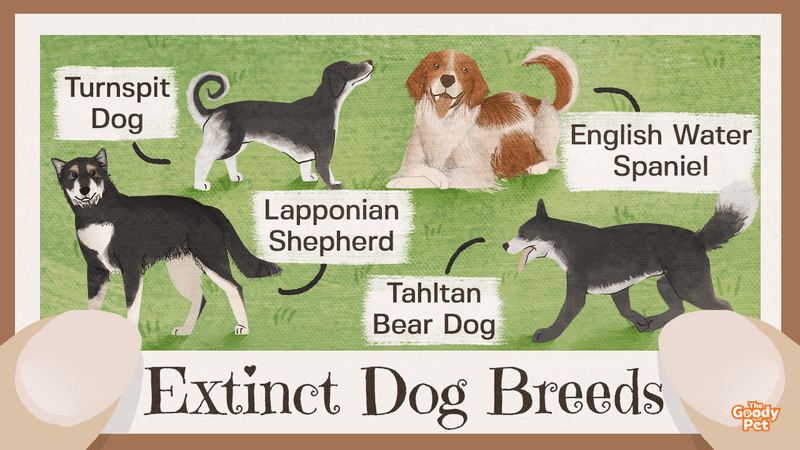Approximately 49 dog breeds have gone extinct in the last 500 years, and many more are endangered. Some of these breeds are so rare that you’ve probably never heard of them.
In this blog post, we’ll introduce you to some of the most obscure extinct dog breeds. From the Tahltan Bear Dog to the Welsh Harlequin, these dogs are all but forgotten now.
But they’re worth remembering for their unique characteristics and history. So without further ado, let’s get started.
49. Paisley Terrier
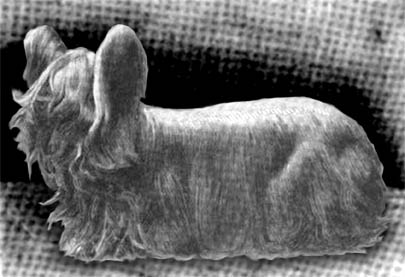
The Paisley Terrier is a direct ancestor to the wildly popular Yorkie Terrier. Like their descendants, these little pups were known for their beautiful coats, which could be grown out and groomed to floor length.
They were also just as spirited and affectionate and were popular companion lapdogs for the working class. They also served as working dogs, mainly helping with killing vermin on farms and serving as watchdogs, where their yappy nature came in handy.
48. Cumberland Sheepdog
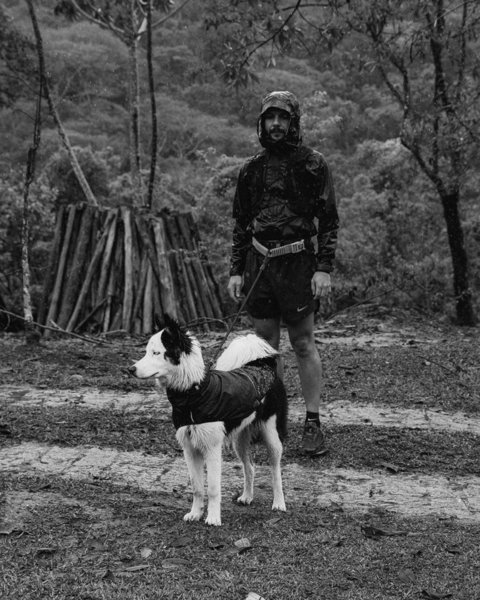
It was used as a herding dog in the Scottish Borders. The Cumberland Sheepdog is thought to be a cross between the Smooth Collie and the Border Collie. It was a large, powerful dog with a thick coat.
The breed was used for both sheep and cattle. Its main job was to keep the animals together and to stop them from running off.
The Cumberland Sheepdog was a working dog and did not have much time for play. It was a loyal and devoted companion, but it could be aggressive if it felt threatened.
This breed was not recognized by any Kennel Club, and very little is known about its history. The last known Cumberland Sheepdog was seen in the early twentieth century.
47. Old Welsh Grey Sheepdog
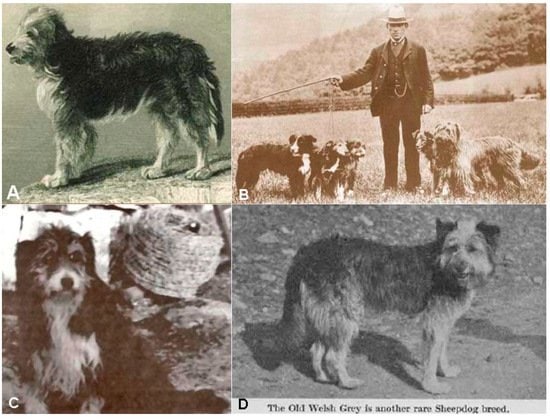
This extinct pooch breed is believed to be one of the main genetic contributors to what is today known as the Welsh Sheepdog.
However, unlike this now popular descendant, the Old Welsh Grey Sheepdog has a bit of a rougher appearance with a long, shaggy coat.
The extinction of this breed is widely considered to be a result of the increased popularity of the versatile and highly intelligent Border Collie in Europe.
46. Seskar Seal Dog
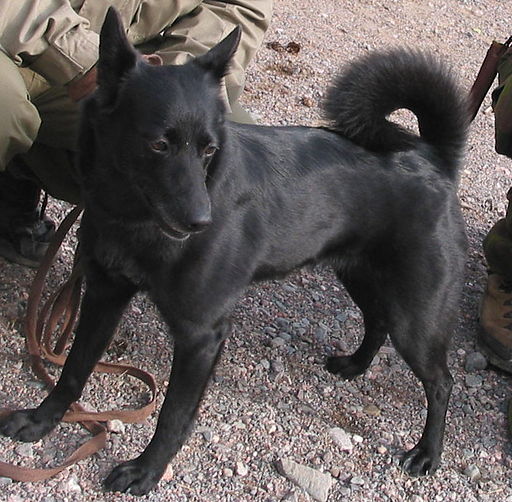
As the name suggests, these breeds were used for hunting seals in northern European countries like Finland. As seal hunting became less popular, their demand and, in turn, their breeding drastically reduced. By the mid-20th century, these dogs were extinct.
Breeders later developed the Seskar dog as an ode to the bright and friendly extinct pooch. However, despite their dark coats and spitz-like appearance, the two breeds have nothing else in common.
45. Thylacine
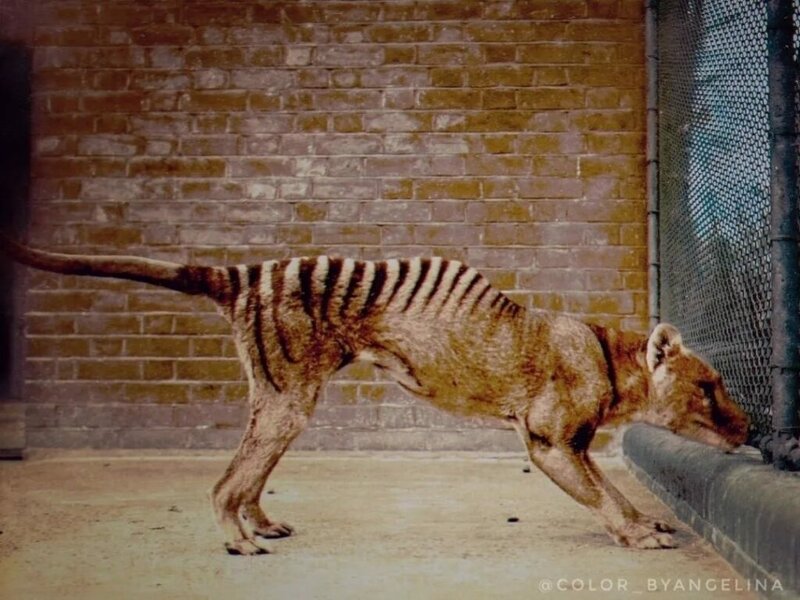
The Thylacine was truly an enigmatic creature. Yes, we call it a creature and not a dog.
This is because, given its physical features and behavior, it is hard to say whether this was a dog in the way that we know dogs. However, the upper torso and head region were very doglike and reminiscent of the wolf ancestors.
However, it was the hind legs, butt, and tail area that threw many historians off. This is because of their big catlike nature, including tiger stripes and a strong, long tail.
44. Terceira Mastiff
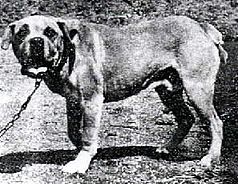
This is an extinct dog that left behind a legacy that can only be described as totally badass. This was mainly due to its foreboding appearance as well as its strong and often aggressive personality.
Local lore has them linked to all sorts of intriguing aspects of history, from their presence in Spanish pirate ships to their history as popular fighting dogs.
Their legacy lives on through some of their ferocious descendants, with the most notable being the Fila Brasileiro.
43. Smithfield
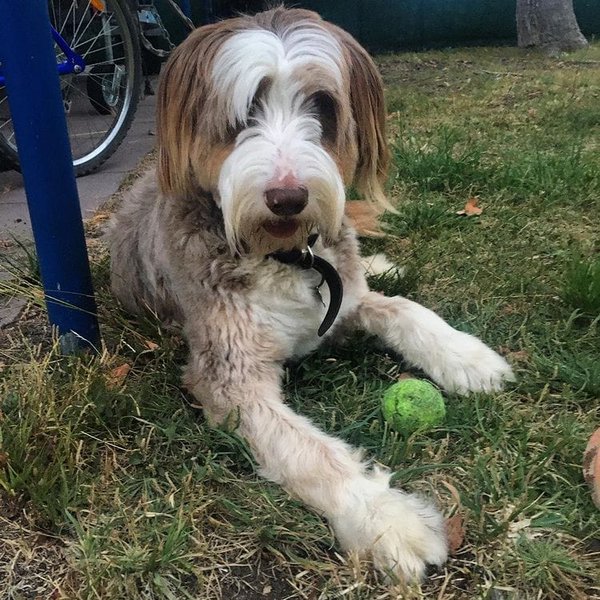
Technically speaking, the Smithfield is not completely extinct. However, it is dangerously close as their numbers play within the range of critically endangered dog breeds.
Unfortunately, this is yet another breed whose demand slowly dwindled as other shepherding dogs, like the Border Collie and German Shepherd, grew in popularity in Europe.
However, there are efforts by several small-scale breeders around the world to revive the breed. And with their sweet personalities and cute little faces, we sure hope they succeed.
42. Sakhalin Husky

These dogs’ slow march toward extinction is closer to our history than many of us realize. In fact, as of 2015, there were only seven Sakhalin Husky purebred dogs around the world.
For the most part, these breeds flew under the radar carrying out different tasks in their homeland of Russia, from sledding to guarding.
It wasn’t until 1958 that they were thrust into the international limelight when 15 of them were left stranded after an Antarctica expedition went wrong.
41. Fuegian Dog

The Fuegian dog is unlike any other breed out there in that it originated not from wolves or foxes but from a South American canid known as a Culpeo.
They were known for their wild features with everything from their wiry fur and their fox-like skull features to their aggressive personalities.
Another unique thing about them is their extinction might have been intentional, with a lot of them being exterminated due to their dangerous nature.
40. Celtic Hound
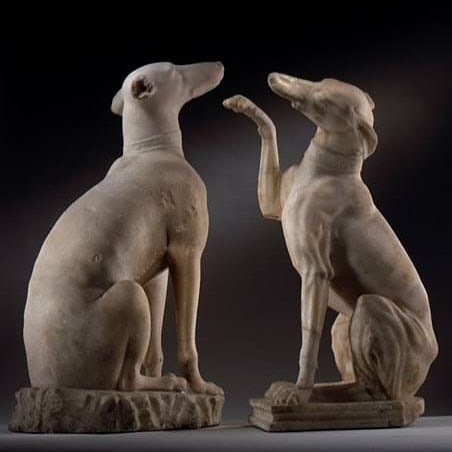
These dogs are legendary, more so than they are historic facts. In fact, there are theories that the dogs referred to in Irish myths are actually different ancestors of breeds like the Greyhound and Iris Wolfhound.
In their day, the hounds were fierce hunting dogs capable of going up against formidable foes, including large, wild animals like wolves. They were valued for their combination of bravery and athletic prowess.
39. Rastreador Brasileiro
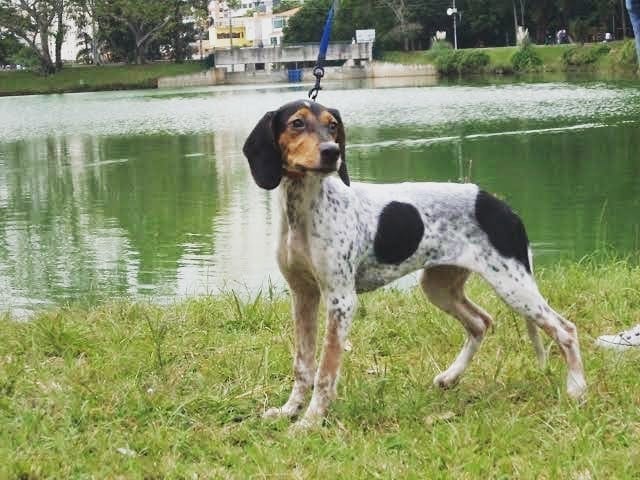
This is a Brazilian breed that was bred as a hunting dog due to its impressive stamina and great scent-tracking skills.
Its extinction story is quite unique compared to others on this list. This is because it was heavily influenced by environmental factors like disease and toxicity from agrochemicals.
Despite efforts by breeders in the area to save the purebred Rastreador dogs for repopulation, the breed was extinct by the late 20th century.
38. Dalbo Dog
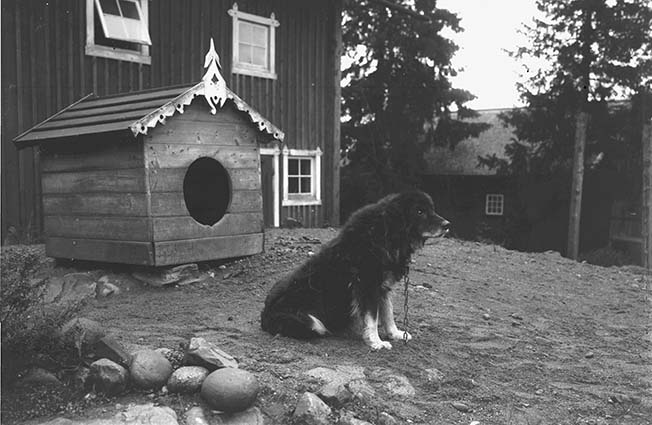
The Dalbo dog was a shepherd dog used not only to guide livestock but also to protect them from wild animals, including wolves and bears. And as a large Molosser type of dog, it was more than up to the task.
However, even in their peak numbers, they were quite rare. This was because they were expensive to keep, and their demand was low.
This, coupled with safer livestock herding regions and a rabies outbreak, had the Dalbo Dog completely extinct a few years into the 20th century.
37. Chiribaya Dog
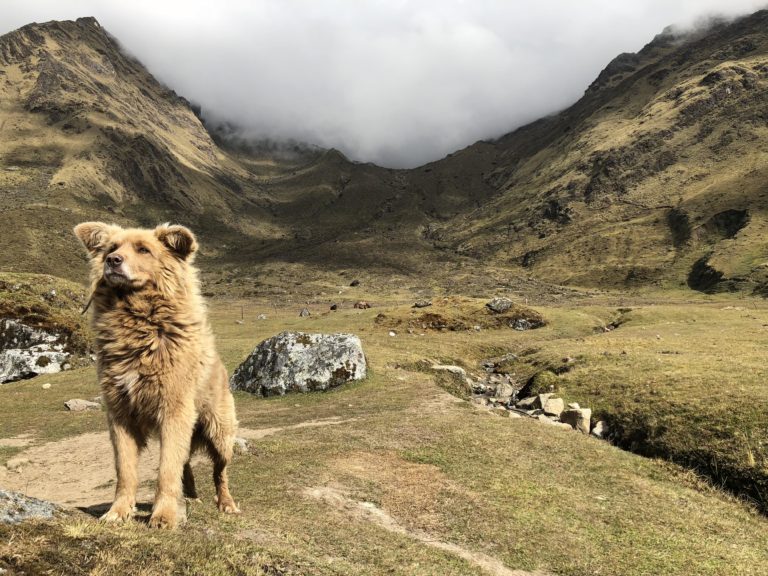
These dogs are likened to breeds like the dachshund today due to their short legs and disproportionately long torsos.
These breeds were greatly valued in their day, both as companion dogs and working dogs. They were very popular and used mainly to help with the herding of llamas and other small livestock.
However, as the Chiribayan society faded into obscurity, so did their numbers, rendering them extinct.
36. Welsh Hillman
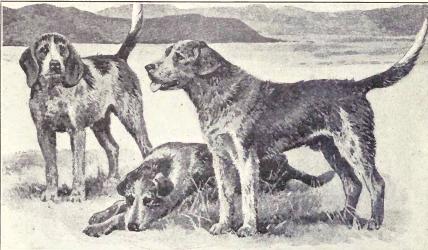
At its peak in popularity, the Welsh Hillman was an incredible herding dog and a plausible descendant of Welsh wolfhounds. It was a combination of sheer strength, agility, endurance, and confidence. This also made it a formidable opponent against most animals that threatened the herd they were taking care of.
Like a few other breeds highlighted on our list, the Welsh Hillman was never a wildly popular dog, and purebred versions were rare even centuries ago.
35. Old Spanish Pointer
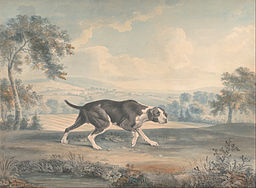
The Old Spanish Pointer is probably the oldest pointing breed. It has contributed to some of the most popular hunting dogs today, including the English Pointer.
It goes without saying that their great intelligence made them very popular. They were very easy to train for specific tasks, like hunting jobs.
They were also very athletic, displaying not only speed and agility but also enough endurance to maintain their momentum through long hunting expeditions.
34. Tahitian Dog
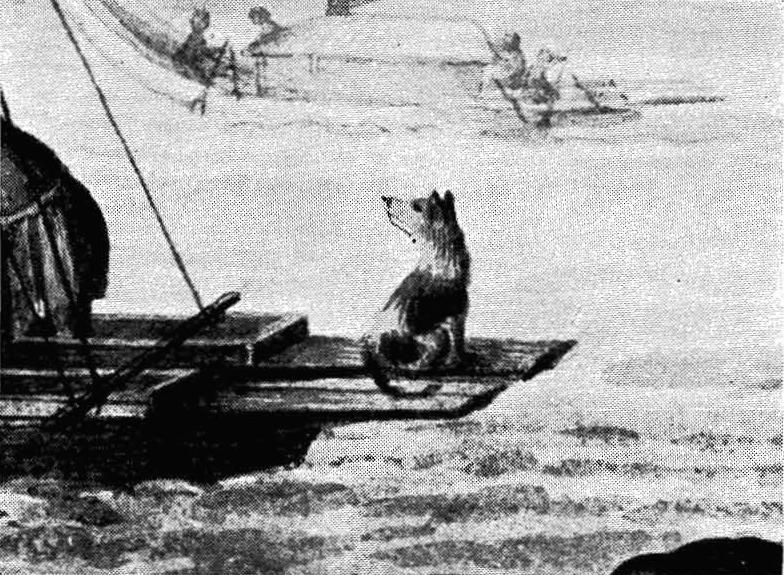
This is one of the five main types of Polynesian dogs introduced to different Pacific Islands thousands of years ago. Specifically, they were found in Tahiti and the Society Islands.
Like their other counterparts that we will discuss in this list of extinct breeds, these dogs served multiple purposes, including being kept for their meat.
These dogs, in particular, were treated well and only served up as delicacies to esteemed guests on very rare and important occasions.
33. Bull And Terrier
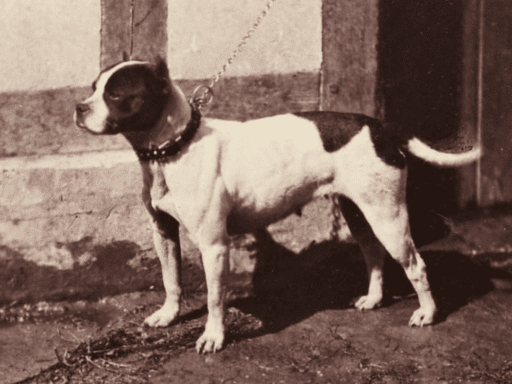
The Bull and Terrier was a mixed breed dog bred from Old English Terriers and Old English Bulldogs.
They themselves have contributed greatly to some of the most famous dog breeds today, including problematic breeds like the Bull Terrier, American Pit Bull, and the American Staffordshire Terrier.
Just like its descendants, this dog had quite a mean streak and was particularly popular in dogfighting circles for its aggression and violence.
32. Argentine Polar Dog
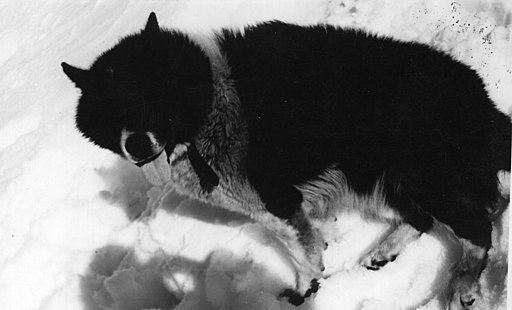
At first glance, the Argentine Polar dog is hard to distinguish from spitz-type breeds today. This is because it is a mix of some of the most popular spitz-like snow dogs, which are the Alaskan Malamute and the Siberian Husky.
They were bred for strength, endurance, and intelligence, which were all traits that came in very handy to the Argentine army.
These impressive dogs did everything from pulling sleds and guiding soldiers to serving as rescue dogs. It’s a real shame they are no longer around.
31. Kurī
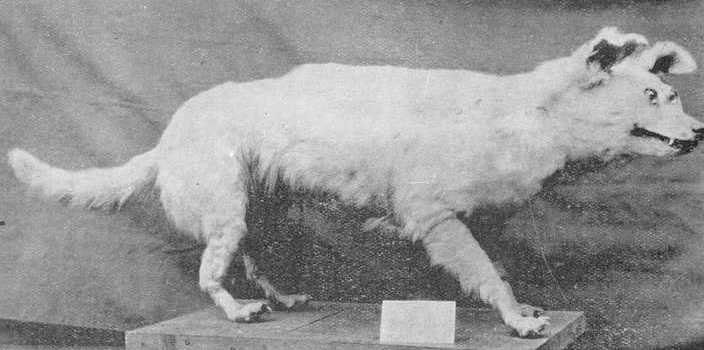
This is another one from the Polynesian dog family and was found mainly in New Zealand.
The common theme of having these dogs as delicacies can be seen when talking about these dogs. However, none have been described in as much detail and with as much praise as the Kurī.
Yes, it is a bit weird imagining our furry best buddies as dinner. However, it is important to remember that these breeds were introduced mainly as part of livestock with other animals like chickens.
30. Salish Wool Dog
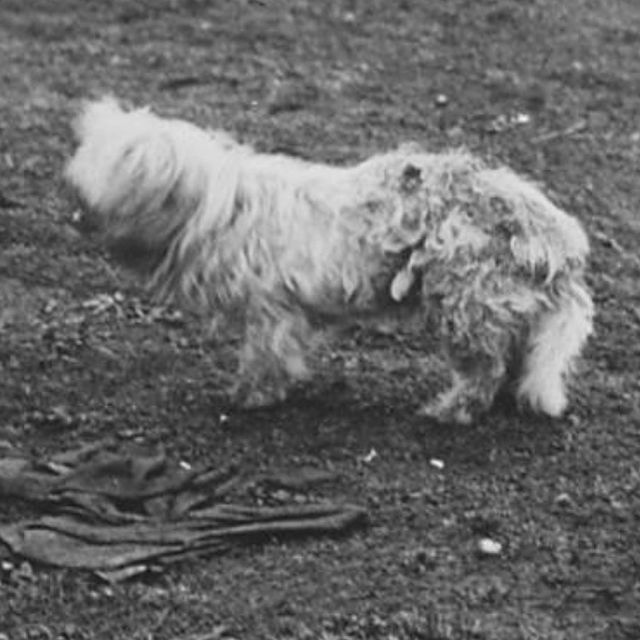
This is yet another dog that was kept for quite a unique purpose. Don’t worry; this one wasn’t on the menu for the Salish People of what is today’s Pacific Northwest region of America.
As the name suggests, these pups were actually kept for their fur. This ancient tribe did not have access to sheep or other woolen livestock and had to rely on the thick coats of the Salish Wool Dog.
29. Hawaiian Poi Dog
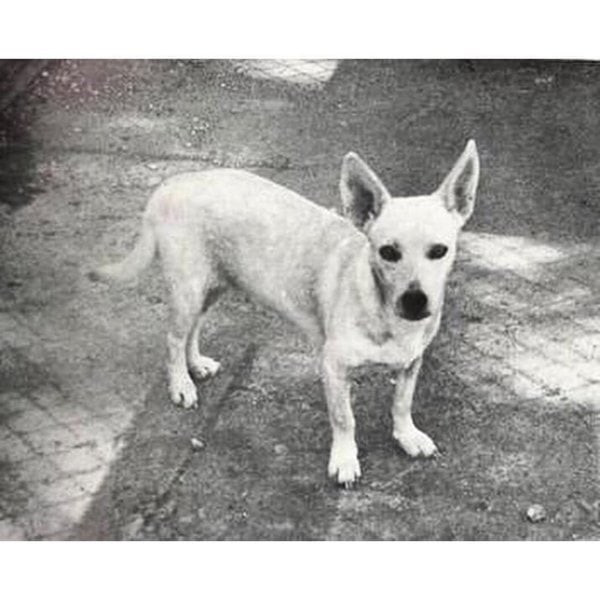
The Hawaiian Poi Dog was one of the first of the Polynesian breeds and is actually thought to be an ancestor to the Kuri breed that was found in New Zealand.
These canine companions were very important to a local culture, where they were kept mainly as lucky charms and as religious symbols. Due to this status, they were rarely consumed except on very rare occasions and by very special people.
28. Braque du Puy
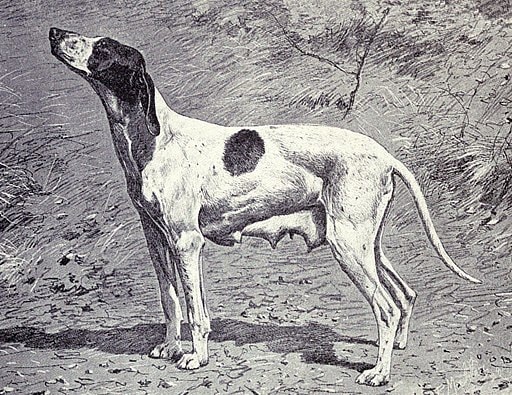
This breed was a hunting masterpiece combining the intelligence and sharp skill of its pointer bloodline with the speed and agility of breeds like the Greyhound that it is believed to have been related to.
This is yet another breed that seemed doomed for extinction from the very start, given how rare they were in their own native country of France. Their extinction was closely linked to both world wars of the 20th century, where hunting was discouraged, and their demand reduced significantly.
27. Alaunt
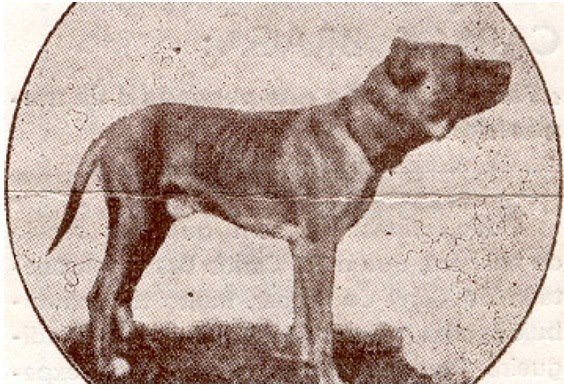
The Alaunt is closely related to Mastiff descendants and resembles breeds like the Dogo Argentino with its short snout, skin flaps, and stocky build. However, that is where all the similarities end, as the Alaunt was a much gentler breed than the Dogo Argentino and other more aggressive relatives.
They were kept primarily as herding dogs for their alertness, dominating personalities, and surprising gentleness towards smaller animals. They were also often kept as companion pets.
26. Talbot Hound
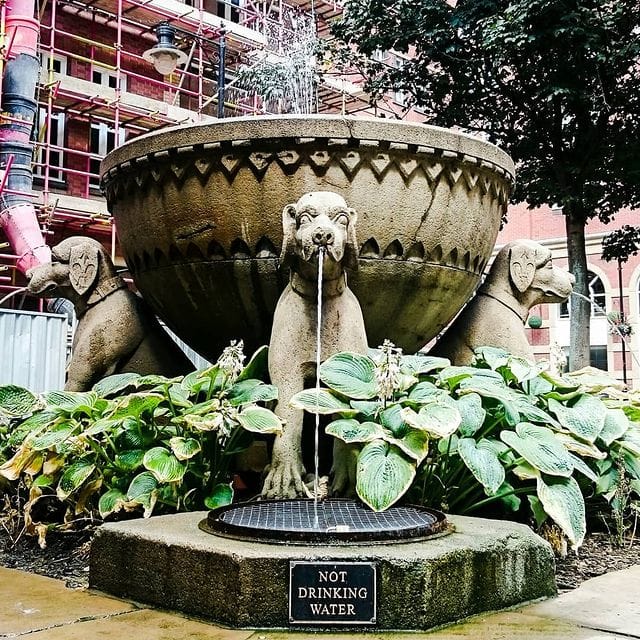
Dog breeders and historians have a hard time figuring out exactly what it was that made the Talbot Hound so special as a hunting breed.
If its relation to modern-day breeds, like the Bloodhound and Beagle, is anything to go by, it was probably their incredible sense of smell. However, historical records also mention their incredible speed and focus, which led some to believe it was also a sighthound.
Whatever the case was, the Talbot Hound was great at its job.
25. North Country Beagle
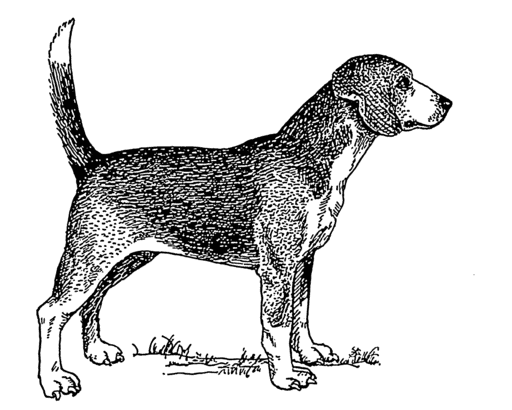
The North Country Beagle was wildly popular in Northern England in the 18th and early 19th centuries. These dogs were used as hunting dogs both for their scent-tracking skills and their great speed.
Their decline in popularity and eventual extinction cannot be traced to a specific factor. However, it is believed that their popularity as parents in mixed breeds was a disadvantage as they failed to live up to their stronger and more effective mixed offspring.
24. English White Terrier
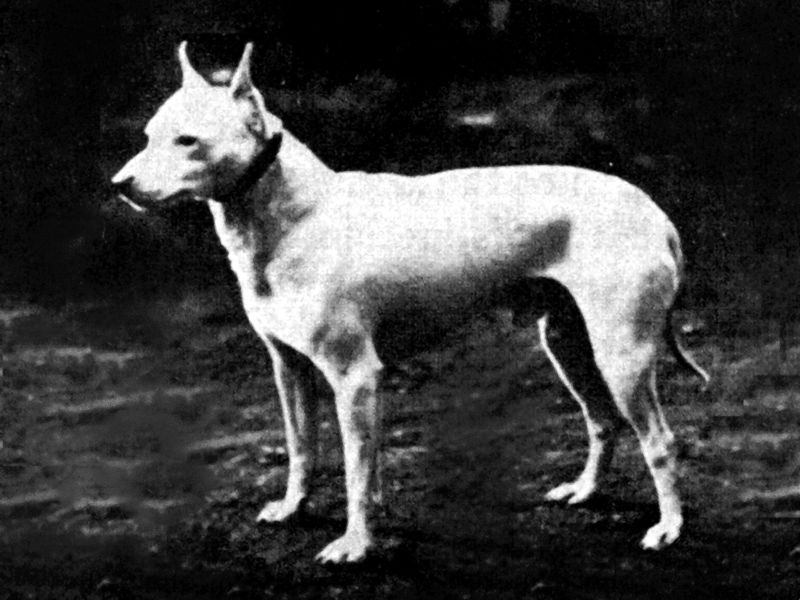
This breed graced mankind with its presence for all of 30 years before disappearing slowly but surely into extinction.
They were developed experimentally by selectively breeding perky-eared varieties of the breed. This was, for the most part, an aesthetic decision meant to make them more appealing to the masses.
To put it gently, this plan blew up massively in their faces, with the resulting English White Terrier turning out sicklier than they had expected.
23. Moscow Water Dog
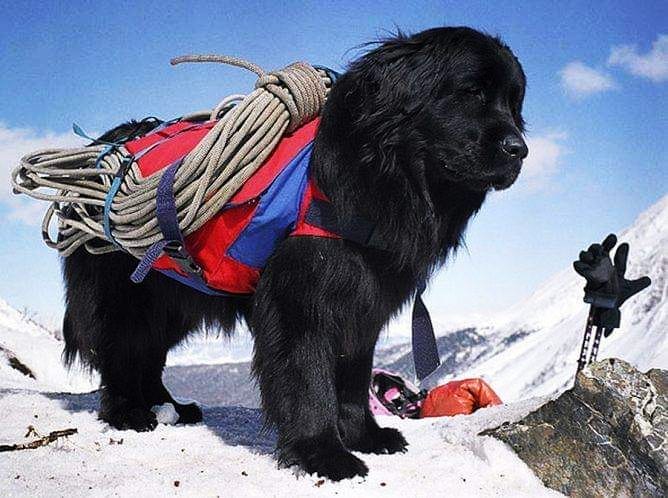
This was one of the products of military breeding efforts by Russia’s Red Star Kennels. The dogs had quite the ancestry with contributions from giant breeds like the Caucasian Shepherd, Newfoundland, and the East European Shepherd.
Size-wise, the dog was just as big as its ancestors, which made it perfect for different jobs in the military, including guarding stations and pulling carts.
Despite their development for use as rescue dogs, their aggression was hard to breed out and made them ineffective in the task.
22. Norfolk Spaniel
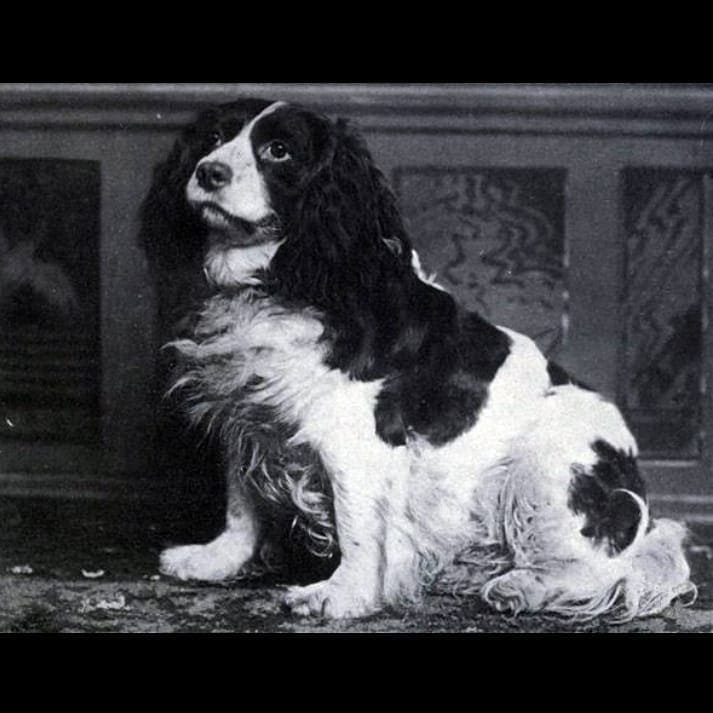
Technically speaking, this breed is not exactly extinct in the way other breeds on our list may be. It just lost its independent breed status and got absorbed into the English Springer Spaniel breed. This was because their numbers were few and the standards too diverse to justify having them as independent breeds.
Their influence can be seen in modern spaniels with traits like their stubbornness and difficulty to train as well as their intense affection for their human handlers.
21. Russian Tracker
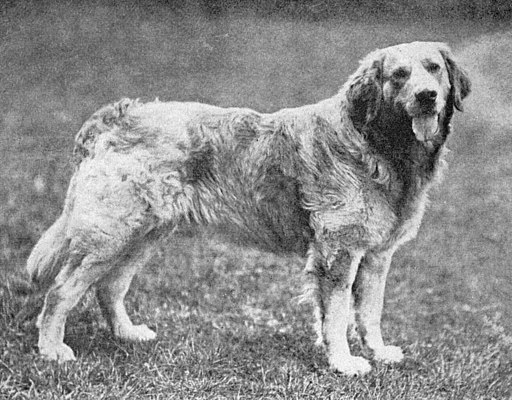
The Russian Tracker is very close in resemblance to the Golden Retriever with everything from the lanky build to the long, wavy, golden locks. This is to be expected, considering that Goldies are actually direct descendants of this extinct breed.
Unlike the retriever, however, these dogs were used more as herding dogs, where they helped to guide and protect livestock. However, they also occasionally served as hunting dogs.
20. Tesem
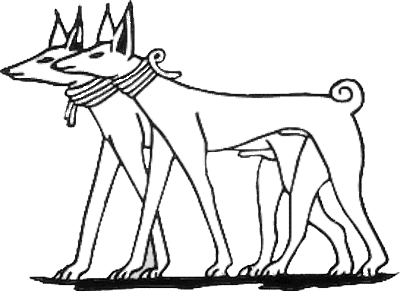
The Tesem was one of the three main dog breeds found in ancient Egyptian drawings. They are closely related to the Sloughi hound dogs and are featured with similarly lean and long forms. This is why it is believed that they were used as hunting dogs as well as for protection purposes for both nobility and civilians in ancient Egypt.
Another distinguishing feature that stands out in their hieroglyphic depictions is their tightly curled tail.
19. Toy Bulldog

Toy breeds are incredibly popular today. However, human infatuation with our tiny furry buddies did not start recently. The Toy Bulldog is the perfect example of this, dating back to the 18th century.
They were developed mainly by selectively breeding smaller Bulldogs in each litter. However, this proved problematic as the Mini Bulldogs were rarely fertile. And when they were, the chances of offspring coming out regular or medium-sized became too high to justify the efforts.
18. Alpine Spaniel
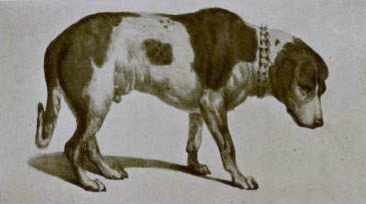
The St. Bernard dog is one of the best-known rescue breeds in the Swiss Alps region, but it is not the only one.
The Alpine Spaniel actually precedes the now popular breed and was used to track lost travelers on the alps and to help drag them back to safety. Where they couldn’t, their incredible sense of direction came in handy when helping rescuers locate those in need of help.
17. English Water Spaniel
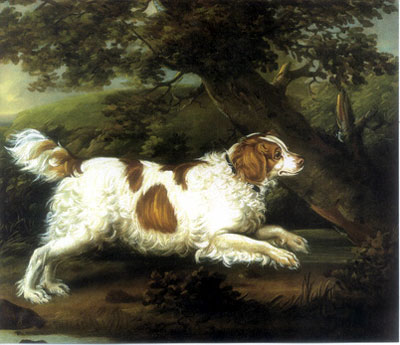
You know, a dog is pretty awesome if it finds its way to great works of literature like Shakespeare’s McBeth. That is exactly the kind of street credit the English Water Spaniel brought to the table back when it was a huge deal in Europe.
These dogs loved the water and were essentially built for it with their thick, waterproof coats and strong legs. That is why they were used in retrieving waterfowl. But as the practice of hunting died down, so did their demand and numbers.
16. Alpine Mastiff
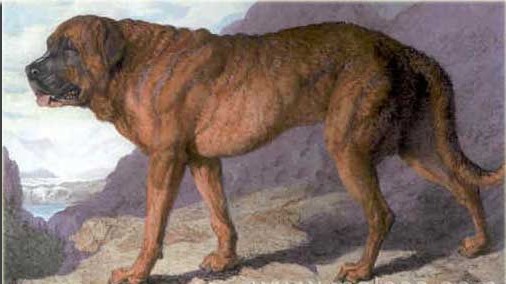
This is one of the biggest dog breeds on our list. It is also considered one of the original giant breeds and has given rise to lovable beasts like the Saint Bernard breed.
These breeds were mainly kept as work dogs due to their sheer strength and their high endurance. They were used to pull carts, herd livestock, and even guard homes. However, their large size made them difficult to take care of which led to their decline in popularity and eventual extinction.
15. Southern Hound
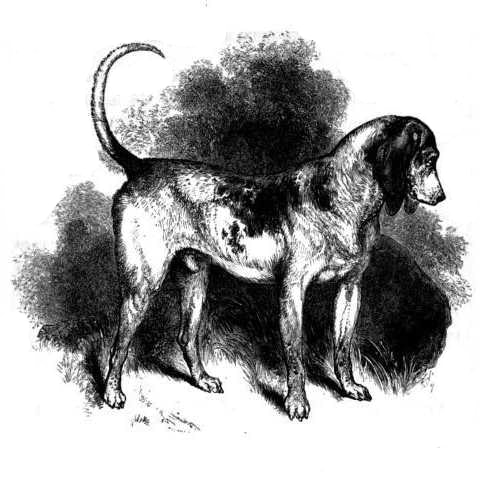
The Southern Hound was a relatively popular hunting dog in its day with its excellent scent-tracking skills. While it was not very fast, it was very resilient and would often be used to wear down prey through relentless chasing.
Due to such traits, the Southern Hound was often used in mixed breeding to produce stronger and faster dogs with the same endurance and scent-tracking skills. Slowly but surely, these superior mixed breeds took over in popularity.
14. Bullenbeisser
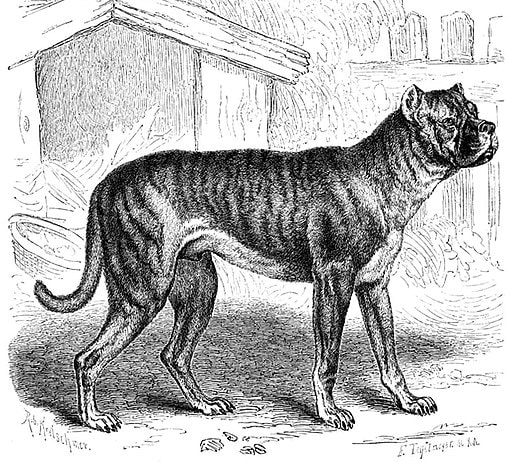
The Bullenbeisser is quite similar in appearance and strengths to other mastiff breeds on this list of extinct dogs, including the Alpine Mastiff. The large dog’s name translates to “bull biter” in Germany, which is why it is otherwise referred to as the German Bulldog.
As with some other breeds on our list, extensive cross-breeding was the main cause of the extinction of this breed as the descendants gained more popularity.
13. Blue Paul Terrier
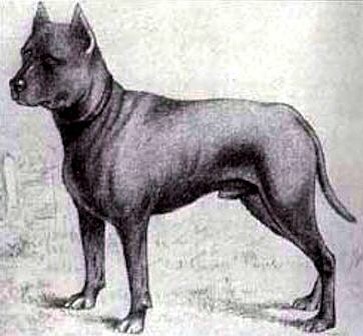
The origins of this now-extinct breed are hotly contested, but it is believed to be a mix of the Irish Blue Terrier and the Bull and Terrier breed from England.
The result was a medium-sized pooch very similar to today’s bulldog with its stocky build, broad skull, and short, shiny fur. The fur was often dark blue or greyish in color, thus their name.
12. Chien-Gris
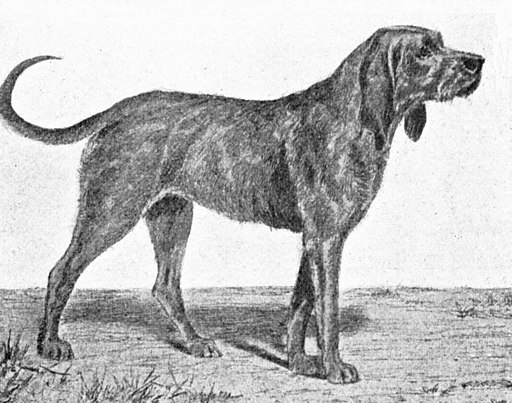
This is easily one of the oldest extinct dog breeds, with roots as far back as medieval times.
It was used primarily as a hunting dog mainly due to its scent-tracking skills. It was also strongly built and, therefore, very agile and resilient, even though not the strongest hound in its day.
Their strong scent-tracking skill, as well as their strength, also made them popular in their prime as guard dogs both domestically and in prisons.
11. Toy Trawler Spaniel
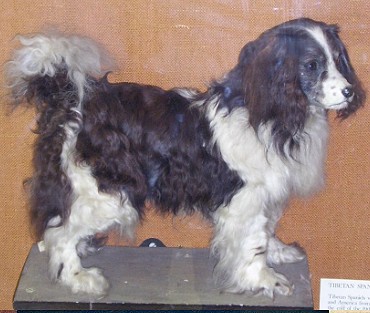
Toy Trawler Spaniel is an extinct dog breed that was once popular in England and Wales. The last known individual died in the early 20th century.
The Toy Trawler Spaniel was a small, sturdy dog with a long body and short legs. They were used as working dogs on fishing boats, and were known for their loyalty and intelligence. Unfortunately, the breed declined in popularity after the introduction of motorized fishing boats in the early 1900s, and the last known individual died in the early 20th century.
While the Toy Trawler Spaniel is now extinct, they live on in memory through paintings and photos from their heyday.
10. Tweed Water Spaniel
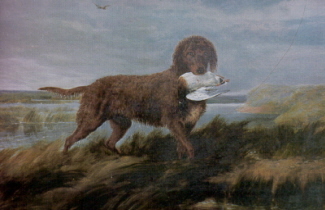
This was a waterdog known for its unique aesthetic with its thick, curly, liver-colored coat. In addition to their use in hunting waterfowl, these dogs were also popular companion pets. They were preferred by outdoorsy dog lovers due to their athletic nature and their general love for the outdoors.
It is very unfortunate that these friendly and super-intelligent dogs are no longer around us. However, their legacy lives on with the likes of the Golden Retriever and the Curly Haired Retriever.
9. Cordoba Fighting Dog
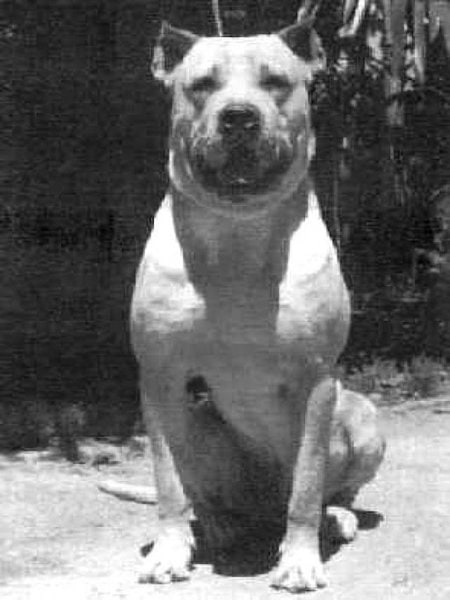
This extinct dog breed had quite a controversial lineage with bloodline contributions from some of the most aggressive dog breeds ever. These include the Boxer, Bulldog, Bull Terrier, and English Mastiff.
They were bred for one thing and one thing only, and that was to fight. Unfortunately, this contributed greatly to their eventual extinction, as most of them died during the brutal fights.
8. Old English Bulldog

This is not to be confused with the Olde English Bulldogge which is actually a recreation of this now extinct dog breed.
The original breed was a bit shorter than modern descendants but was just as athletic. They were kept mainly for the purpose of bull-baiting which definitely contributed to their dwindling numbers over the years.
They were rarely kept as companion pets due to their unruly nature and their predisposition to aggressive behavior.
7. Turnspit Dog
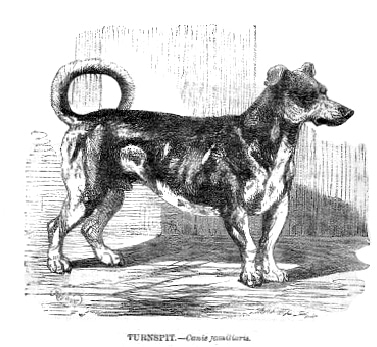
Like most of the breeds on our list of extinct breeds, the disappearance of the Turnspit Dog had everything to do with their purpose and the demand trends over time.
They got their name from their job, which was to turn contraptions used for cooking meat over fires. However, as automated systems became available to even the lowliest of chefs, the demand for these dogs plummeted. Eventually, no one needed them, and so no one bred them.
6. St. John’s Water Dog
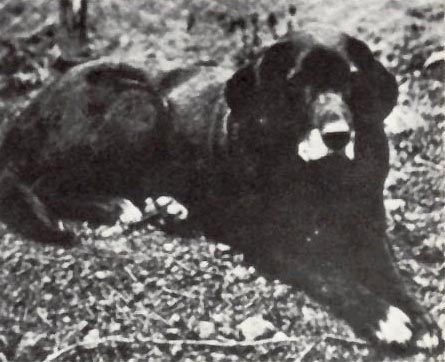
The Newfoundland region of Canada is widely celebrated in the dog world for giving us the gift of the gentle giant that is the Newfoundland Dog.
However, this was not the only breed worth celebrating to have hailed from this land.
The St. John’s Water Dog is actually sometimes referred to as the Lesser Newfoundland Dog. They may not have been as popular as their larger comrades, but they were valued enough to be used to create one of the most successful breed families, the retrievers.
5. Molossus
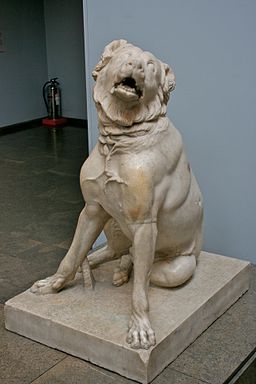
This is a truly ancient breed that can be traced back to the old Greek kingdom of Molossia. This was so much more than a dog to people back then and was considered more of a cultural symbol with appearances in all genres of ancient literature.
This was mainly due to its large size, incredible strength, high intelligence, and confidence.
Unfortunately, a combination of factors, including extensive mixed breeding and environmental catastrophes, robbed us of the privilege of ever getting to see their greatness for ourselves.
4. Tahltan Bear Dog
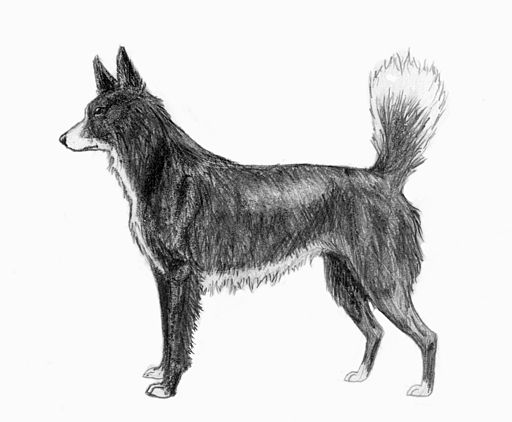
This is yet another gem from Canada. However, they were very rare when they were still around. However, lack of demand sealed their fate with their extinction in the late 20th century.
The mid-sized dog was spitz-like in appearance and, despite its compact form, was quite strong and confident. It was, therefore, often used for things like guarding homes and livestock as well as light manual labor around farms in Northern Canada.
3. Hare Indian Dog
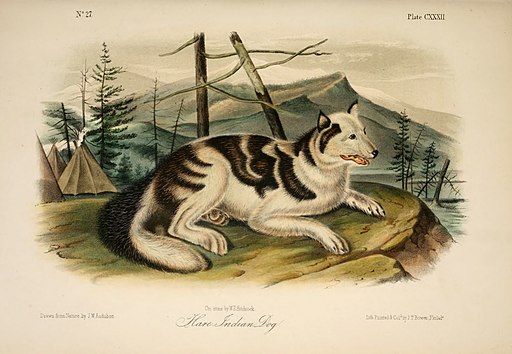
The word “Indian” here is used to refer to native tribes in northern Canada, where this dog was first domesticated. Unlike many extinct pooches on our list, the Hare Indian Dog was a pure breed and is actually believed to have been domesticated from jackals or wild dogs in the area.
Whatever its origins, the dog was used by these tribes as a hunting dog specifically for tracking and chasing small prey like a hare.
2. Lapponian Shepherd
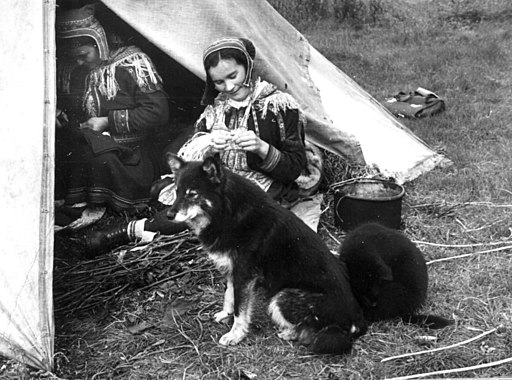
Despite popular beliefs, the Lapponian Shepherd did not actually originate from the Lapland region of Finland. However, the people who bred and used them mostly in the southern regions were from there.
They very closely resemble relatives like the Alaskan Malamute and the Siberian Husky with their wolf-like appearance and their black and white or black and tan coats. Like their relatives, they were also primarily used for pulling sleds.
1. Marquesan Dog
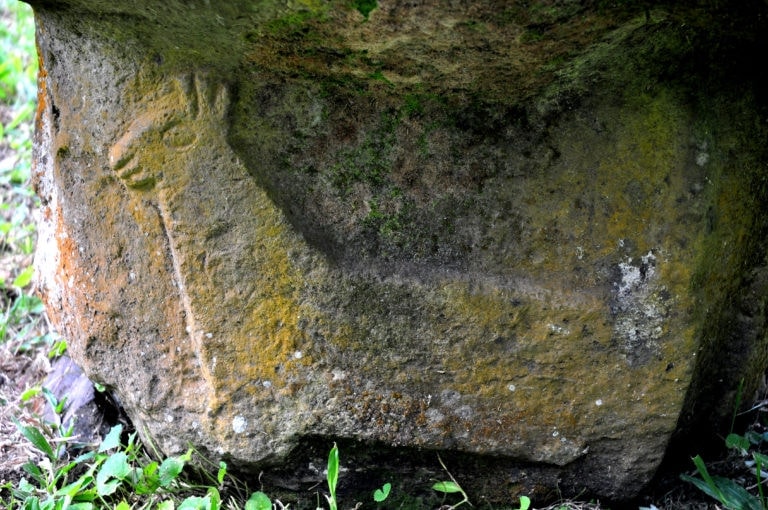
The Marquesan Dog is an ancient breed that was native to Pacific Islands and inhabited by Polynesian settlers. Unlike breeds today, these dogs were kept for a mixture of religious purposes as well as for consumption.
Yep, you read that right.
What is interesting about this breed is that it was always a rare dog, even back when it was still around. It seems it never really stood a chance of surviving into modern times.
Related Questions
How Do Dog Breeds Go Extinct?
Dog breeds can go extinct for a number of reasons. The most common reason is simply that the demand for the breed decreases, and people are no longer interested in breeding them. This can happen for a variety of reasons, such as changes in fashion or lifestyle. Sometimes, a particular health issue affecting a breed can make it less desirable, and people will stop breeding them.
Where Did Dogs Come From Originally?
Dogs are believed to be originally from Europe, where they evolved from wolves and were domesticated. Initially, their domestication was for tasks including pulling carts and sleds as well as guarding. However, they soon became companion pets and even show pets as dog competitions became more popular.
What Was The 1st Breed Of Dog?
It is widely believed that the oldest dog breed in history is the Basenji. It can be traced back to Central Africa and is also found in ancient Egyptian depictions. However, there is some controversy with this title among other historians claiming that the Japanese Akita is the oldest dog breed in existence.

